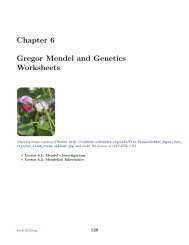Life Cycle of Seedless Vascular Plants - Wikispaces
Life Cycle of Seedless Vascular Plants - Wikispaces
Life Cycle of Seedless Vascular Plants - Wikispaces
You also want an ePaper? Increase the reach of your titles
YUMPU automatically turns print PDFs into web optimized ePapers that Google loves.
tropisms. <strong>Plants</strong> also respond to daily and seasonal cycles and to disease.Lesson Review QuestionsRecall1. List special challenges that aquatic plants face.2. What are xerophytes? Give an example.3. Identify three general ways that plants can adapt to extreme dryness.4. Describe how epiphytes can absorb moisture without growing roots in soil.5. What is the primary way that plants respond to environmental stimuli? What controls their responses?6. Define tropism. Name one example in plants.7. State ways that plants respond to disease.Apply Concepts8. Apply the concept <strong>of</strong> symbiosis to epiphytes and their host plants. Do you think they have a symbioticrelationship? If so, which type <strong>of</strong> symbiotic relationship do you think they have? Explain your answer.Think Critically9. Why are epiphytes found mainly in rainforest ecosystems?10. Why is it adaptive for plants to detect and respond to daily and seasonal changes?EOL Research11. Bromeliads are some <strong>of</strong> the most common epiphytes. Research bromeliads at EOL and discuss theevolution <strong>of</strong> these species. See the Communities and Populations chapter for information about EOL.Points to ConsiderIn this chapter you read about the cells, tissues, and organs that make up plants. You also read aboutplant life cycles. Like plants, animals are complex organisms with tissues and organs. Animals also havelife cycles.• How do the cells <strong>of</strong> animals differ from those <strong>of</strong> plants? What tissues and organs might be found inanimals?• What is the general animal life cycle? How does it differ from the general life cycle <strong>of</strong> plants?Image Sources(1) Mangrove: Cesar Paes Barreto; Bloodroot: William Curtis. [Mangrove:http://commons.wikimedia.org/wiki/File:Roots_by_cesarpb.jpg; Bloodroot: http:www.ck12.org 438





